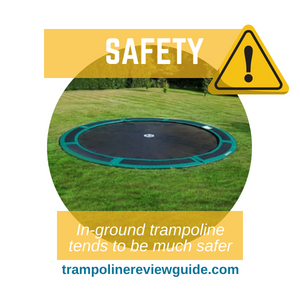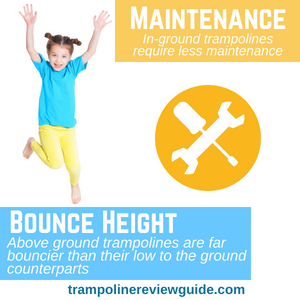Above Ground Trampoline VS In Ground (Which To Buy In 2019?)

Most trampolines are “above ground trampolines” – they stand on metal legs (sometimes wrapped in foam) on top of the ground in a backyard, park, or play area. But there’s also something known as “in-ground trampolines”, an outdoor-only style of trampoline in which the base of the trampoline is sunk into the ground for stability.
Our readers want to know: in the battle of above ground trampoline VS in ground, who wins? Which is cheaper, safer, easier to set up? Are there major benefits to in-ground trampolines that make them the clear winner over their more common above ground competitors? Or does the annoying of digging holes for the frame outweigh the benefits?
If you’ve been wondering whether to buy an above-ground or in-ground trampoline, look no further.
Contents
Landscape

For those whose top priority is the presentation of their yard, in-ground trampolines are the clear winner. Obviously, we at Trampoline Review Guide love the look of a good trampoline, but manufacturers of these large pieces of outdoor activity equipment are usually concerned with safety and quality first.
The big lumps of foam and metal and netting are often garishly colored (especially if they’re intended to appeal to kids) and are not necessarily the most aesthetically pleasing thing to look at.
In-ground trampoline types, on the other hand, keep a low profile and blend in with the surroundings of the yard. They also take up less space, allowing you to have room in even a small or medium-sized backyard for other things.
Having said that, there are a lot of good above ground trampoline landscape ideas on the Internet if you know what to look. Some people decorate their trampolines in cool ways or turn them into other things when they’re not in use. Still, if you want something that’s going to look good as part of a landscape right out of the box, in-ground is the way to go.

Safety
When it comes to an above ground trampoline vs in ground, the latter tends to be much safer. Most trampoline accidents occur when a child or adult jumps off the trampoline and hits the ground at speed, something that simply isn’t a problem with a low to the ground trampoline.
In addition, younger children can’t get under the trampoline and be bounced on or get their fingers caught in the springs if everything under the trampoline mat itself is safely underground.
Setup

When it comes to the setup of an above ground trampoline vs in ground, there’s no competition – above ground trampolines win. Setting up an in-ground trampoline requires you to find a perfectly level spot in the yard where you can legally dig, followed by digging holes, setting up the trampoline (a chore in and of itself), and refilling the holes in such a way that the trampoline will not move or be moved by strong weather conditions.
A low to the ground trampoline also requires you to make sure that you dig the whole in such a way that you can still bounce – a trampoline that’s literally just sitting on the ground can’t spring and is little more than a waste of money.
Conversely, setting up an above ground trampoline just requires buying the trampoline, picking a convenient spot, and following the instructions in the manual. They can be set up in the spring or summer and taken down in the winter, and they’re easy to move if you want to put it somewhere else or if you’re moving to a new house.
Most above ground trampoline manufacturers will even provide you with expert installation at an additional fee – so if you like, you don’t have to do anything to set this trampoline type up yourself.
Maintenance
In-ground trampolines require less maintenance than a traditional above ground trampoline. A low to the ground or fully sunken trampoline is less exposed to the outside elements, and the fact that the metal frame is completely hidden means you shouldn’t have to worry about rust.

Having said that, above ground trampolines do have one advantage in this area: they can be brought indoors during the winter. When snow piles up on a trampoline, even on that’s sunk into the ground, it can cause serious permanent damage. But for most areas and climates, an in-ground trampoline will still be the preferred option.
Bounce Height
Because above ground trampolines are elevated, there is more space for air to pass through the mat. This increases the bounce capacity and elasticity of the trampoline. Depending on how you set up your in-ground trampoline type, the above ground version may also give users more vertical room for each bounce.
For these reasons, above ground trampolines are far bouncier than their low to the ground counterparts, which often feel like you’re just jumping up and down on a hard surface.
Portability/Movability

You can probably guess who wins for portability when it comes to above ground trampoline vs in ground. To move an above-ground trampoline, all you have to do is pick it up and move it.
But because an in-ground trampoline type is literally buried in the ground, moving it requires a lot of digging and filling of holes. It’s a huge hassle.
Price
Above ground trampolines are almost always cheaper than a low to the ground trampoline type. Not only are they cheaper out of the box, but they’re cheaper to set up because you don’t need as many specialized tools.
In fact, fairly expensive expert installation is almost always the best and cheapest way to set up an in-ground trampoline – and that can add nearly $200 to the initial cost of an already-expensive piece of equipment.
One small way in which you save money on a low to the ground trampoline is that if it’s partially or completely buried, you don’t have to buy trampoline anchors, stakes, or ties like you do for an above ground trampoline in windy areas. But for most people, this minor saving won’t make up for the cost of the trampoline and its assembly.
Better For Children Or Adults?
Whether above ground or below ground, there are many different trampoline types, makes, and models. After all, indoor toddler trampolines would technically be considered above ground, but so would the huge adult trampolines used by Olympic gymnasts.
So this kind of generalization is not necessarily appropriate when looking at the above ground trampoline VS in ground question, and no result is going to be true in 100 percent of cases.
Having said that, in most cases we would recommend below ground trampolines for children and above ground trampolines for adults. Because below ground trampolines do not require any sort of ladder or step stool to get into, they are more accessible for young children.
They are also safer because if you bounce off of them you won’t crash and hit the ground at speed – you’ll just jump onto the nearby grass or dirt.
But for adults, in ground trampolines aren’t as fun because they tend to be much smaller and never provide as much bounce as an above ground trampoline (for the reasons we described in a previous section.) Also, adults will hopefully be a little more careful than children and won’t accidentally jump off of the mat.
Above Ground Trampoline VS In Ground – Our Winner
Both of these different trampoline types have their advantages. Above ground trampolines are better for adults, as well as those who live in areas where strong wind is less of a concern.
They’re also more portable, easier to set up, and much cheaper than their competition. However, in ground trampolines are safer and more attractive as part of a backyard landscape.
Overall, above ground trampolines won four of our seven categories, while below the ground trampolines only won three. So when it comes to the question of above ground trampolines vs in ground, it looks like the above ground trampoline type is better overall, while the in-ground version might be a niche product better for those with children or other specific concerns.




